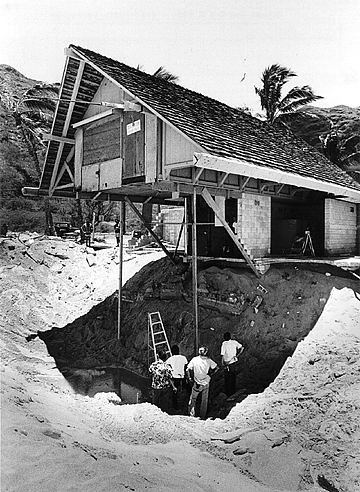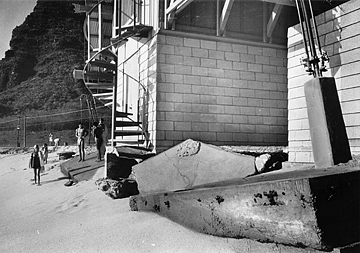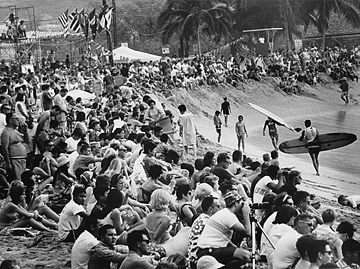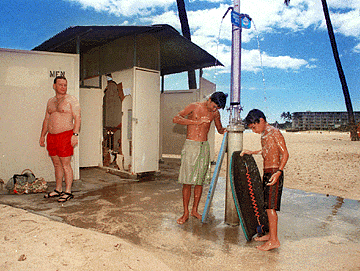
In early 1980, storms washed away so much sand at Makaha
that the foundation of the bathhouse was exposed.

In early 1980, storms washed away so much sand at Makaha
that the foundation of the bathhouse was exposed.
Not bad for a shy Nanakuli boy who used to consider it a huge adventure to travel all the way to Waikiki for a paddling contest. But whenever he finds himself in a glamorous surf spot far from Hawaii, Keaulana's heart remains true to his power source: Makaha Beach.
Keaulana is happiest when breathing deeply of Makaha's salt-laden sea breeze. Makaha has provided fish and other food for his family, waves to satisfy his soul and a classroom where he has taught generations of Waianae Coast residents to understand and enjoy the mysteries of the bountiful ocean.
Through a lifetime spent diving, swimming, surfing and paddling in the waters off Makaha, Keaulana's heart beats to the rhythm of the waves and his blood flows with the rise and fall of the tides.

The city shored up the building, but to no avail. In February 1983,
the ocean took its final toll.
Mauka of the highway, cars filled a field that formed a natural amphitheater, allowing people to sit atop their autos for a spectacular view of the big-wave contest.
Makaha is still a treasure of the Waianae Coast, a generous playground where parents lovingly dunk babies in the ocean for the first time while keiki splash in the shore break and learn about waves by getting knocked down and jumping back up for more. Older kids paddle bodyboards farther out to ride waves, while beyond them teens on shortboards rip the bigger surf.
And barely visible from shore, the old bulls on longboards wait patiently for the big waves that will carry them to shore.

The foundation of the bathhouse in 1961 was eroding, as evidenced
by the slanting slab under the showers and the jagged pieces
of concrete at the foot of the stairway.
"They drive all the way out here and have to go back to Waianae to use the bathroom. The bathhouse here is so bad it's easy to throw rocks at it and vandalize it. They have a nice one at Keawaula (near Kaena Point) now, but Makaha still has nothing."
If only the city had listened to Keaulana. Coming ashore after a surf session in 1959, he spotted city workers laying the foundation for a new bathhouse. "Gee, you know the waves wash up here all the time," he told them. "But they nevah like listen, their mind was made up already."
Although convinced that disaster loomed for the new bathhouse, Keaulana was reluctant to make too much noise. After all, the city had just hired him to take care of Makaha Beach Park.
Sure enough, soon after Keaulana and his wife, Momi, moved into the groundskeeper's quarters above the bathhouse, the waves came pounding at the door.
For the next eight years while Keaulana landscaped the park and raised his children at Makaha Beach, the waves continued to wash up against the bathhouse and snatch sand from beneath its foundations.
Finally, in 1969, in recognition of all the people Keaulana had rescued from the ocean, Mayor Neal Blaisdell named him Makaha's first lifeguard. No longer the groundskeeper, he moved from the quarters with great regret.
"The old bathhouse was fabulous," Keaulana says. "It had showers on the boys' and girls' sides, it had changing rooms, three toilets on each side and urinals. And it had a storage room between the two restrooms where the groundskeeper and lifeguards could store their equipment.
"It was the cleanest, best bathhouse."
But just as Keaulana had predicted, the bathhouse was doomed. Over the years, the ocean redoubled its efforts to prove Keaulana right. Big waves toppled walls, which the city doggedly rebuilt. Surging seas ripped out showers, which were replaced.
Little by little, repairs were made more slowly. Finally, pieces of the bathhouse were scattered all over the beach, while the tattered main structure remained standing. "For several years, people still used the urinal even when the walls were all broken down. It was really a sad thing for a great beach like that."
The bathhouse resisted Hurricane Iwa's wind and wave assault in November 1982, but the following February a giant west swell finally toppled the rest of the once-
proud bathhouse, and the Keaulanas' former home was no more.
The community has been waiting 13 years for a new bathhouse to replace the "temporary" restrooms that most people avoid. "When I'm down at the beach I don't use that bathroom, there is no privacy," says Momi Keaulana. "I go to my son's house.
"Imagine all the tourists that come down to the famous Makaha Beach from all over the world. How shameful."

The Makaha International Surfing Championships held the
day after Christmas 1967 attracted huge crowds.
Photo by Bob Young, Star-Bulletin
Right across Farrington Highway from Makaha Beach, the city is sitting on a gold mine. In 1970, for less than $500,000, the city snagged 11 acres of land, a wonderful place to build a new bathhouse. "A lot of people in the community don't even know this land is available for a park," says Dennis Gouveia, who for 20 years has been a lifeguard at Makaha with Keaulana.
"Everybody thought the beach was all there was. We told them it belongs to the people. Now we have to stand together to make sure they develop it right."
According to city parks planner Don Griffin, the city has always intended to turn the mauka parcel into a park, bathhouse and parking lot. But it would be a nightmare having a steady stream of people trying to weave from a mauka parking lot through cars speeding along Farrington Highway. So the city has been waiting for the state to move Farrington Highway behind the park area.
The highway is congested with a dangerous mix of fast cars, school kids, surfers and beachgoers. "We cringe even now with the kids out of school crossing the street and going to the beach," says Gouveia.
Years ago the state proposed moving the road mauka, but there was such an outcry because it would displace some people that the state abandoned the plan. There is another potential problem as well. One of the small pleasures of life is to pull into a parking spot at Makaha and watch the action from the comfort of your car. That thrill would be obliterated if the road were rerouted. "If you're going to have facilities and make the area attractive, you have to give up something in the process," Griffin says.
Hopes were high that the fallow land would bloom when the state began replacing bridges and paving roads north of Makaha and repaving Farrington Highway south of the beach after a sewer line project was completed. But the work halted on each side of Makaha and the state claimed it ran out of money to continue. Officials say there are no current plans to reroute the highway around the city's park land.

The present facility, put up as a temporary bathhouse 13 years ago,
is small and falling apart, too.
Photo by Dennis Oda, Star-Bulletin
While cautiously optimistic, Keaulana will believe it when he sees the foundations being laid to rebuild his beloved old bathhouse beyond the reach of the waves.
"If they ever build that bathhouse, when I die you can spread my ashes there so I can greet everybody who uses it."